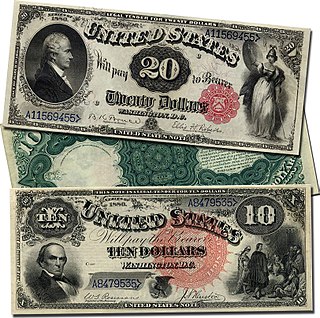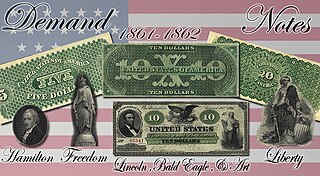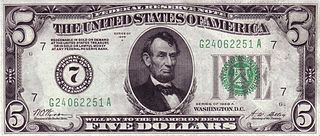
Federal Reserve Notes, also United States banknotes, are the banknotes currently used in the United States of America. Denominated in United States dollars, Federal Reserve Notes are printed by the United States Bureau of Engraving and Printing on paper made by Crane & Co. of Dalton, Massachusetts. Federal Reserve Notes are the only type of U.S. banknote currently produced. Federal Reserve Notes are authorized by Section 16 of the Federal Reserve Act of 1913 and are issued to the Federal Reserve Banks at the discretion of the Board of Governors of the Federal Reserve System. The notes are then put into circulation by the Federal Reserve Banks, at which point they become liabilities of the Federal Reserve Banks and obligations of the United States.

A United States Note, also known as a Legal Tender Note, is a type of paper money that was issued from 1862 to 1971 in the U.S. Having been current for 109 years, they were issued for longer than any other form of U.S. paper money. They were known popularly as "greenbacks", a name inherited from the earlier greenbacks, the Demand Notes, that they replaced in 1862. Often termed Legal Tender Notes, they were named United States Notes by the First Legal Tender Act, which authorized them as a form of fiat currency. During the 1860s the so-called second obligation on the reverse of the notes stated:
This Note is a Legal Tender for All Debts Public and Private Except Duties On Imports And Interest On The Public Debt; And Is Redeemable In Payment Of All Loans Made To The United States.

The United States five-dollar bill ($5) is a denomination of United States currency. The current $5 bill features the 16th U.S. President (1861-65), Abraham Lincoln's portrait on the front and the Lincoln Memorial on the back. All $5 bills issued today are Federal Reserve Notes.

The United States ten-dollar bill ($10) is a denomination of U.S. currency. The obverse of the bill features the portrait of Alexander Hamilton, who served as the first U.S. Secretary of the Treasury. The reverse features the U.S. Treasury Building. All $10 bills issued today are Federal Reserve Notes.

The United States twenty-dollar bill ($20) is a denomination of U.S. currency. The seventh U.S. president (1829–1837), Andrew Jackson, has been featured on the front side of the bill since 1928; the White House is featured on the reverse.

The United States fifty-dollar bill ($50) is a denomination of United States currency. The 18th U.S. President (1869-77), Ulysses S. Grant, is featured on the obverse, while the U.S. Capitol is featured on the reverse. All current-issue $50 bills are Federal Reserve Notes.
Large denominations of United States currency greater than $100 were circulated by the United States Treasury until 1969. Since then, U.S. dollar banknotes have only been issued in seven denominations: $1, $2, $5, $10, $20, $50, and $100.

The United States one-dollar bill ($1) since 1876 has been the lowest value denomination of United States paper currency. An image of the first U.S. President (1789–1797), George Washington, based on the Athenaeum Portrait, a 1796 painting by Gilbert Stuart, is currently featured on the obverse, and the Great Seal of the United States is featured on the reverse. The one-dollar bill has the oldest overall design of all U.S. currency currently being produced. The obverse design of the dollar bill seen today debuted in 1963 when it was first issued as a Federal Reserve Note.

Silver certificates are a type of representative money issued between 1878 and 1964 in the United States as part of its circulation of paper currency. They were produced in response to silver agitation by citizens who were angered by the Fourth Coinage Act, which had effectively placed the United States on a gold standard. The certificates were initially redeemable for their face value of silver dollar coins and later in raw silver bullion. Since 1968 they have been redeemable only in Federal Reserve Notes and are thus obsolete, but still valid legal tender at their face value and thus are still an accepted form of currency.

A gold certificate in general is a certificate of ownership that gold owners hold instead of storing the actual gold. It has both a historic meaning as a U.S. paper currency (1863–1933) and a current meaning as a way to invest in gold.

National Bank Notes were United States currency banknotes issued by National banks chartered by the United States Government. The notes were usually backed by United States bonds the bank deposited with the United States Treasury. In addition, banks were required to maintain a redemption fund amounting to five percent of any outstanding note balance, in gold or "lawful money".
The history of the United States Dollar refers to more than 240 years since the Continental Congress of the United States authorized the issuance of Continental Currency in 1775. On April 2, 1792, the United States Congress created the United States dollar as the country's standard unit of money. The term dollar had already been in common usage since the colonial period when it referred to eight-real coin used by the Spanish throughout New Spain.

A Demand Note is a type of United States paper money that was issued between August 1861 and April 1862 during the American Civil War in denominations of 5, 10, and 20 US$. Demand Notes were the first issue of paper money by the United States that achieved wide circulation and they are still in circulation today, though they are now extremely rare. The U.S. government placed the Demand Notes into circulation by using them to pay expenses incurred during the Civil War including the salaries of its workers and military personnel.

The Series of 1928 was the first issue of small-size currency printed and released by the U.S. government. These notes, first released to the public on July 10, 1929, were the first standardized notes in terms of design and characteristics, featuring similar portraits and other facets. These notes were also the first to measure 6.14" by 2.61", quite a bit smaller than the large-sized predecessors of Series 1923 and earlier that measured 7.421 8" by 3.125"
This page is a glossary of notaphily. Notaphily is the study of paper money or banknotes.

The United States dollar is the official currency of the United States and its territories per the Coinage Act of 1792. One dollar is divided into 100 cents or 1000 mills. The Coinage Act of 1792 created a decimal currency by creating the following coins: tenth dollar, one-twentieth dollar, one-hundredth dollar. In addition the act created the dollar, half dollar, and quarter dollar coins. All of these coins are still minted in 2020.

Birds of Canada is the fifth series of banknotes of the Canadian dollar issued by the Bank of Canada and was first circulated in 1986 to replace the 1969 Scenes of Canada series. Each note features a bird indigenous to Canada in its design. The banknotes weigh 1 gram with dimensions of 152.40 by 69.85 millimetres. It was succeeded by the 2001 Canadian Journey series.
Multiple types of banknotes of the United States dollar have been issued, including Federal Reserve Notes, Silver Certificates, Gold certificates and United States Notes.

The United States two-dollar bill ($2) is a current denomination of U.S. currency. A portrait of Thomas Jefferson, the third President of the United States (1801–09), is featured on the obverse of the note. The reverse features an engraving of the painting Declaration of Independence by John Trumbull.



























